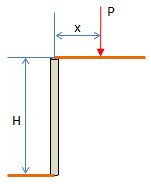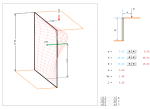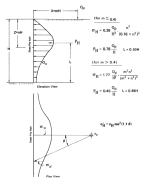SURCHARGE LOADS (POINT LOAD)

Description
Retaining walls are built in order to hold back earth which would otherwise move downwards. A surcharge load results from forces that are applied along the surface of the backfill behind the wall. These forces apply additional lateral forces along the back of the wall. This spreadsheet calculates the resulting pressure field acting on the retaining wall due to a point load at a given position behind the wall.
Calculation Reference
Surcharge Loads
Pile Design
Geotechnics
Surcharge loads are additional loads that are applied to the ground surface above a soil mass, affecting the stress distribution within the soil. Point loads, also known as concentrated loads, are one type of surcharge load where the load is applied over a small area, such as the load from a column or a post. Point loads can significantly impact the stress distribution within the soil, causing an increase in vertical and horizontal stresses beneath the load application point.
To analyze the effects of surcharge point loads on the soil, you can use the Boussinesq's theory of stress distribution, which provides a mathematical method for determining the vertical and horizontal stresses at any point within an elastic, homogeneous, and isotropic half-space due to a point load applied at the surface.
The vertical stress increase (?σz) at a point within the soil due to a surcharge point load (P) can be calculated using Boussinesq's equation:
?σz = (3P / 2π) * (z / (r² + z²)^(5/2))
Where:
- P is the applied point load
- z is the depth below the ground surface to the point where the vertical stress increase is being calculated
- r is the radial distance from the vertical line passing through the point load to the point where the vertical stress increase is being calculated
Similarly, the horizontal stress increase (?σr) due to the point load can be determined using another Boussinesq's equation:
?σr = (3P / 2π) * (z² / (r² + z²)^(5/2))
Surcharge point loads can significantly impact the design of various geotechnical structures, such as foundations, retaining walls, and tunnels. It is crucial to consider the effects of these loads in the design process and analyze the soil's response to the increased stresses. Additionally, it is essential to consult with experienced geotechnical engineers and apply appropriate design codes to ensure the safety and efficiency of the structures being designed.
Calculation Preview
Full download access to any calculation is available to users with a paid or awarded subscription (XLC Pro).
Subscriptions are free to contributors to the site, alternatively they can be purchased.
Click here for information on subscriptions.



